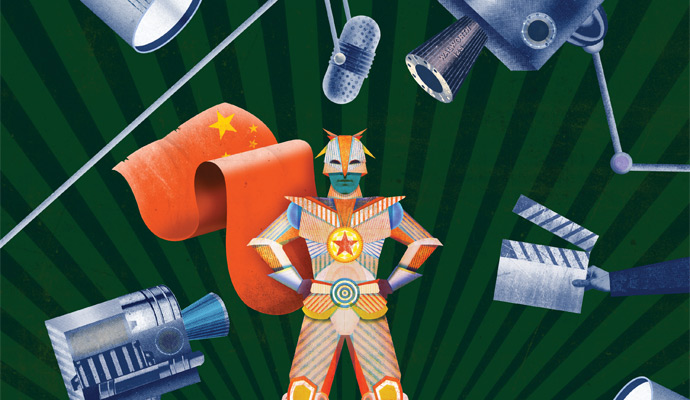Netflix Wasn’t All Wrong
Six months after video rental company CEO Reed Hastings was forced into a strategic retreat from Qwikster, strategists can still learn a lot from his decision.
This article was written with Kasturi Rangan.
In October 2011, one of the great backflips in the annals of business strategy took place. Netflix Inc., the most prominent video rental service company in the world, had begun to charge separately for its DVD-by-mail service and its streaming service in July, which in effect had increased prices by 60 percent for customers who used both services. Then, in September, Netflix had gone further, announcing it would split those services into two separate businesses, renaming the DVD-by-mail operation Qwikster. Consumer protests, conducted largely over the Internet, forced the retraction in October; Netflix announced it would revert to providing a combined service under one brand. By November, the company’s market cap had dropped by 70 percent and more than 800,000 subscribers had fled. The online mea culpa that CEO Reed Hastings wrote to customers only added fuel to the flames. In January 2012, a group of investors sued the company for loss of profits. Clearly, a bit of the company’s luster as a Silicon Valley darling has been lost, and Reed Hastings’s reputation as a strategically adept CEO has been damaged.
The unfolding lawsuit will undoubtedly raise more questions about Hastings’s judgment and culpability. The company stumbled, and in the end the consequences may be serious. But when you take a deeper look — beyond the hype and recriminations — the implications for business strategy, particularly in the Internet era, are more nuanced. Reed Hastings and his team got some important things wrong in changing the Netflix strategy, but they also got a great deal right. Here is our scorecard.
The business split. They got this right. The natural boundaries between the physical (mail) and virtual (streaming) markets for pre-recorded movies are increasingly sharp, especially as the streaming market takes off. These two delivery models require distinct assets and capabilities to be successful, and each faces a very different group of competitors. Physical competitors include Blockbuster and Redbox, whereas virtual rivals include Amazon, Hulu, iTunes, LoveFilm, and cable TV companies.
Netflix’s decision to split the businesses was the right one because it created focus and increased the company’s chances of being successful with distinctive business strategies tailored to different natural markets. To thrive, Netflix will have to find a way to execute well with these two bifurcated operating models under one corporate umbrella. As Hastings recently said, Netflix can expect to lose mail-only subscribers every quarter from now on. Thus, he and his team will be managing one business (DVDs by mail) for decline while growing its replacement (streaming) in the face of fierce competition from a new set of formidable rivals. This is one of the toughest challenges a company can have.
Pricing. They got this right, too. Services that deliver discs by mail have different demand curves from those that stream video content, and they also have very different costs to serve their customers. That’s why different pricing schemes make sense. Netflix’s much-decried 60 percent price increase was assessed only on those who signed up for both mail and streaming. Most observers didn’t recognize this point. The net effective price increase, when applied to Netflix’s entire subscriber base, was closer to 20 percent.
Before July 2011, Netflix had bundled streaming with its core delivery-by-mail service because it was a nascent market and the selection of available videos was limited. The market had not been ready for a stand-alone streaming-only business. During that period, Netflix subsidized the development of its streaming business by essentially giving it away to its DVD-by-mail subscribers. Later, though, with competition from the likes of Apple and Amazon, that would have to change.
Of course, nobody likes a price increase, and even after the company finally adjusted its pricing model, there was still a lot of noise from the customer base. But, as the dust settles, it has turned out that Netflix lost less than 5 percent of its customers (800,000 out of a subscriber base of nearly 24 million). Adjusting its pricing was the right decision, and the company has notably stuck by that decision.
Brand management. The company really didn’t think this through. Netflix chose to make explicit the distinction between its two business models by giving them separate brands — Qwikster for the original by-mail business and Netflix for the new streaming business — and requiring separate unlinked accounts. This was a tricky and unfortunate decision.
Netflix had built its brand on being an innovative, consumer-centric company that revolutionized the way movies were rented. It allowed people to move from the inconvenient bricks-and-mortar chain store model to one with online, assisted selection; home delivery of DVDs in an iconic red envelope; and, most importantly, no returns, no late fees, and no “library fine”–style guilt. The brand was built on those attributes, and it engendered significant loyalty among its subscriber base. The decision to change the original business brand name to Qwikster in one fell swoop was apparently based on the premise that the Netflix brand would be more valuable in the newer streaming space. But it was a misstep. The equally swift reversal of the decision might have controlled some of the damage, but there has probably been some permanent dilution of brand equity. In retrospect, it would have been wiser to find a way to brand both services as Netflix, or if a new brand was necessary, to apply it to the new service.
Communications. Where do we start? After charting an unerring path for so long with consumers, it was surprising to see Netflix make so many fundamental mistakes on the communications front.
Some will say that Netflix got its strategy wrong. Others will say the strategy was right but poorly implemented. Ultimately, the distinction doesn’t matter; missteps of this magnitude become strategic issues.
In the meantime, the Netflix debacle offers some important lessons for strategists. First, timing is sometimes the hardest part of strategy to get right. Netflix likely judged correctly that its mail business was going to be cannibalized and ultimately replaced by streaming. But no one can really know for sure how fast that might happen. Moving too early can be disastrous, as Netflix learned, but moving too late can be even worse — as companies such as Kodak, Research in Motion, and Nokia have discovered. Another aspect of timing, the speed of change, is also difficult to master. Netflix sprang its new service on its customers too abruptly. People need time to adjust.
Second, strategy should be based on how customers behave, not on what they say. Before Netflix announced its change, customers had posted many online messages about the value of switching to streaming. But talk is cheap. Netflix learned this when it began to implement the change, asking customers to switch to a new account if they wanted their videos by streaming instead of mail — and then customers balked.
Third, when customers have an intense loyalty to a particular product (or service or brand), they become nearly as vested in the product as the company is. Coca-Cola Company learned this lesson the hard way in 1985, when it replaced its original flagship cola with a new cola. Many of Coke’s most loyal consumers were outraged by its unilateral decision to take away “their” product. Likewise, Netflix’s customers were outraged when the company took the Netflix name away from “their” original mail service.
Finally, strategy has to be dynamic and iterative. Customer reaction to any change in a company’s value proposition is difficult to know a priori, even with the best market research. Having the agility to change your choices when new information comes to light is essential to strategy success. This type of agility, no matter what mistakes Netflix made, may save the company in the end. In fact, Netflix announced in January that in its latest quarter it had already replaced three-fourths of the subscribers who left last fall. Likewise, the stock has recovered much of the loss it sustained during the backlash.![]()
Author profiles:
- Ken Favaro is a senior partner with Booz & Company based in New York. He leads the firm’s work in enterprise strategy and finance.
- Kasturi Rangan is a principal with Booz & Company in Cleveland. He focuses on corporate and business unit growth strategies for automotive and other industrial companies.



